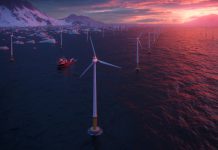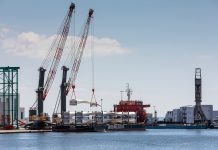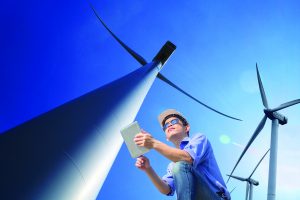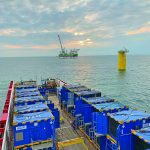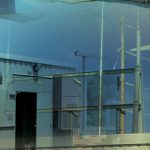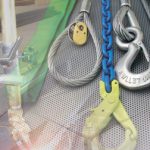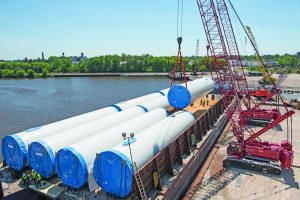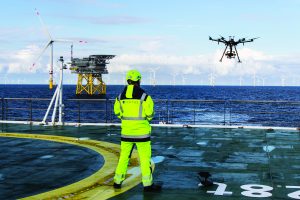As one of the power industry’s leading technology solutions provider, ABB Inc. has made its mark as a key enabler and pacesetter in wind energy by helping its customers generate, connect, monitor, and control power generated from wind farms.
With global headquarters in Zurich, Switzerland, ABB — formerly known as Asea Brown Boveri — was the result of a merger between Asea AB of Sweden and BBC Brown Boveri Ltd. of Baden, Switzerland in 1988. The merged entity became the world’s leading supplier in the $50 billion electricity industry. At that time, ABB controlled as much as one-third of Europe’s electric power business and more than 20 percent of the world market. It successfully integrated 850 subsidiary companies and 180,000 employees operating in 140 countries.
 In 1989, ABB acquired the transmission and distribution business of Westinghouse Electric Corporation, the founder of which developed the transformer as a means to transmit massive amounts of power from his hydroelectric plant in Niagara Falls to Buffalo, New York, 20 miles away. This acquisition gave ABB a foot in the door to the North American utilities market, leading it to support 20,000 employees and approximately 80 manufacturing facilities. Its U.S. corporate headquarters are based in Cary, North Carolina, while its Power Grids headquarters are located in nearby Raleigh on the Centennial Campus of North Carolina State University and its world-class school of engineering. While ABB focuses on a wide range of industries, including oil and gas, pulp and paper, food and beverage, microgrids, utilities, and solar power, it has made a name for itself as a worldwide leader in wind energy technology and connecting wind farms to the grid.
In 1989, ABB acquired the transmission and distribution business of Westinghouse Electric Corporation, the founder of which developed the transformer as a means to transmit massive amounts of power from his hydroelectric plant in Niagara Falls to Buffalo, New York, 20 miles away. This acquisition gave ABB a foot in the door to the North American utilities market, leading it to support 20,000 employees and approximately 80 manufacturing facilities. Its U.S. corporate headquarters are based in Cary, North Carolina, while its Power Grids headquarters are located in nearby Raleigh on the Centennial Campus of North Carolina State University and its world-class school of engineering. While ABB focuses on a wide range of industries, including oil and gas, pulp and paper, food and beverage, microgrids, utilities, and solar power, it has made a name for itself as a worldwide leader in wind energy technology and connecting wind farms to the grid.
“From the time that the wind comes into a turbine to the time that it hits the grid, ABB can offer all of the major electrical components that you need for that electrical drivetrain to transform that power from wind energy into electrical energy on the grid,” said Dennis McKinley, the director of wind power solutions in North America for ABB.
ABB began working with wind turbine OEMs more than 20 years ago by delivering generators and various electrical components for the turbine. With its utility industry expertise, ABB provides front-end studies on wind projects from a technical and technology-feasibility standpoint, including where the best place is to tie into the grid, what kind of infrastructure is required to make that tie into the grid, and the supply of all of the major electrical infrastructure needed in the turbine and on the ground level.
“We had all of the electrical components required, and we had already established a partnership with the major utilities, so it just made sense to start working in the wind industry and supply it with total turnkey-type solutions as well as individual products,” McKinley said. “We supply all of the major electrical components required, including generators, converters, transformers, low-voltage products for protection and controls, motors for pitch and yaw systems, and medium-voltage switchgears. In terms of the electrical balance of plant (eBoP), we can supply everything from the transformers at the base of the towers all the way to the collection systems, substation, and grid tie-ins.”
Utility-scale wind turbines have two main electrical drivetrain concepts — doubly fed and full converter. According to McKinley, the main differences between the two are the type and size of generator used and the function of the converter.
“Even though the market has been dominated by the doubly-fed concept, there are several factors pushing for a shift toward full-converter, including grid code compliance and optimized power generation at slower wind speeds,” McKinley said. “Each of the electrical drivetrain concepts affects the turbine’s weight, size, and maintenance requirements. Selecting an electrical drivetrain concept needs to be done carefully, weighing the requirements of the turbine with the needed certifications and grid code specifications that apply once the turbine is installed.”
That’s where ABB comes in.
 “We’re like the Intel inside of your computer when it comes to the wind power industry because we’ve got all of the electrical components covered,” McKinley said. “We are engineering-focused with an eye toward long-term quality and energy efficiency. Once the customer selects the electrical drivetrain concept, our expert engineers can work with the manufacturer to discuss and integrate ABB products into the turbine engineering drawings, specifications, and plans. Turbine manufacturers benefit from ABB’s experience, resulting in design cost savings and increased efficiencies. When you look at the breadth of ABB, from the consulting team to the service capabilities we have after the project has been installed and commissioned, we have a soup to nuts approach to supporting the industry. It’s all an electrical drivetrain from the time the wind comes in to the time it hits the grid.”
“We’re like the Intel inside of your computer when it comes to the wind power industry because we’ve got all of the electrical components covered,” McKinley said. “We are engineering-focused with an eye toward long-term quality and energy efficiency. Once the customer selects the electrical drivetrain concept, our expert engineers can work with the manufacturer to discuss and integrate ABB products into the turbine engineering drawings, specifications, and plans. Turbine manufacturers benefit from ABB’s experience, resulting in design cost savings and increased efficiencies. When you look at the breadth of ABB, from the consulting team to the service capabilities we have after the project has been installed and commissioned, we have a soup to nuts approach to supporting the industry. It’s all an electrical drivetrain from the time the wind comes in to the time it hits the grid.”
According to Bill Rose, the manager of media and public relations for ABB’s Power Grids division in North America, ABB is one of the few suppliers that has been involved in the commercialization of wind power since the industry’s early days.
“As the largest supplier of electrical components, grid connection systems, and consulting services to the wind power industry, we have decades of experience and have installed more equipment in wind farms than any other supplier,” Rose said. “ABB’s wind industry expertise ensures our products are designed for long life cycles and changing industry regulations.”
As an example, ABB has been a supplier of transformers for more than 100 years. And, according to Rose, the company sold one transformer 80 years ago that is still in operation today in New York.
“When that unit was purchased, it wasn’t expected to last for 80 years, but it has,” Rose said. “We have a very active Power Service organization within ABB, and we do a lot of work with the utilities and follow-up with these products. Most transformers have a life span of 25 to 35 years, and many of the transformers on the U.S. grid today are at least 40 to 50 years old. In other words, they’re living on borrowed time. The utility companies and the operators know that they need to replace them, but there isn’t always capex room in the budget to do so.
“At ABB, we understand that,” Rose said. “So we have an active service organization that is available to provide the on-site consultations and maintenance services required to keep those components working properly. In fact, 70 percent of all transformers on the U.S. grid were made by ABB or by our legacy companies.”
ABB also offers a wide variety of safety-oriented products, and according to McKinley, it’s a leader in industries like wind where arc flash is a potential safety issue.
“Safety is paramount inside of ABB,” McKinley said. “We start each one of our customer and staff meetings off with a safety moment, which is anything that happens from a safety standpoint, like if an employee is harmed or if there is potential for it. When a safety moment occurs, they immediately stop work, put a team around it, take actions, and come up with a solution for it. That solution is developed over time and spread out throughout the company to prevent it from happening again.
“For example, we developed technology that, in the event of an arc flash, pushes the arc, the power, and the damage away from the person and ducts it out through a safe position. At ABB, we work with some electrical equipment that if you don’t do things right, you could be seriously hurt or potentially face a fatal accident, so safety is a big concern.”
 ABB is also a leader in the industry through its power consulting services. According to McKinley, wind farm developers depend on ABB to provide reliable, high-performance wind power generation solutions. Factors such as components needed to collect wind power, boundary conditions, and grid-connection strategy can significantly impact the success of a wind farm, and ABB’s wind and utility expertise helps improve efficiency and maximize generation capabilities.
ABB is also a leader in the industry through its power consulting services. According to McKinley, wind farm developers depend on ABB to provide reliable, high-performance wind power generation solutions. Factors such as components needed to collect wind power, boundary conditions, and grid-connection strategy can significantly impact the success of a wind farm, and ABB’s wind and utility expertise helps improve efficiency and maximize generation capabilities.
“We try to get involved in a wind project as early as we can so that our consulting unit provides the critical system planning, technology feasibility studies, and other site-specific analyses early in the initial design of the farm,” McKinley said. “We also have teams that work on the design side with the customers. The turbine OEMs are always looking for more power output, more efficient power coming out, smaller footprint, and less weight. The research and development inside ABB is very strong with that in mind. We offer some of the most energy-efficient products available.”
In addition to realizing the full power potential of a farm, ABB provides a comprehensive approach that ensures grid integration and grid code compliance.
“Our decades of experience with utilities and their specifications, including appropriate reactive power handling, system impact, and the maximum power injected into the grid, help us drive the approval, testing, and final implementation processes for the farm,” McKinley said.
ABB also leads the industry on an educational level, working closely with the federal and local governments to educate them on the state of the wind market, the potential it presents for job opportunities, and the benefits from offshore wind energy generation.
“We’ve done projects offshore where we can provide the substation platforms that collect the power,” McKinley said. “We’ve completed one project where we did three offshore collection systems totaling approximately 300 MW that fed into another substation that converts the AC power into high-voltage DC power. It’s about 125 kilometers offshore, so we also provided the subsea cabling. We ran the cabling to shore, and that fed into a substation onshore, which ran approximately 75 kilometers onshore and to another substation that converted it back to AC power. We’re a leader in the high-voltage DC (HVDC) market space as well, and that technology plays very well into the wind industry, especially when you have long lines to run the power.”
McKinley added that while the U.S. is moving in the right direction with the development of its first offshore wind farm on Block Island, there’s still a ways to go to catch up with other parts of the world where offshore wind farm development is on the rise.
“There’s a lot of work going on toward having offshore wind development in the U.S., but based on federal and state regional laws and regulations, it’s kind of low,” McKinley said. “It’s moving forward, but it’s not being adopted as fast as it is in Europe and elsewhere. One of the key things to remember is that in Europe, they had to resort to offshore because they didn’t have the space for it onshore for all of the power they were looking for. The U.S. is a different beast because we still have a lot of different regions that have yet to be filled out with onshore wind, which is less expensive than offshore wind. The only catch is that in the west market space where onshore development is booming, the grid infrastructure isn’t there to run the power across the country. That’s the challenge with the onshore wind, and that’s where offshore wind could step in.”
McKinley, who has served on numerous boards for the American Wind Energy Association (AWEA), said that he expects the wind energy industry to continue growing and thriving under the recent five-year production tax credit (PTC) extension, and he said that ABB will play a key role in moving the industry forward.
“We’re a technology leader, so we’re constantly looking for new, innovative technologies that can help make wind energy more effective and last longer, as well as ways to make the industry a more dominant leader in the energy sector,” McKinley said.
For more information, go to www.abb.com/windpower.
















